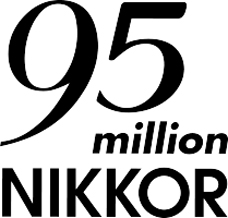
Nikon announced today that they have produced a total of 95 million interchangeable Nikkor lenses. Here is the timeline of the previous Nikkor milestones:
- 65 million Nikkor lenses in October, 2011
- 70 million Nikkor lenses in June, 2012
- 75 million Nikkor lenses in November, 2012
- 80 million Nikkor lenses in June, 2013
- 85 million Nikkor lenses in January,2014
- 90 million Nikkor lenses in November, 2014
Press release:
TOKYO – Nikon Corporation is pleased to announce that total production of NIKKOR lenses*1 for Nikon interchangeable lens cameras reached ninety-five million in the middle of July, 2015.
In 1959, Nikon (then Nippon Kogaku K.K.) released the Nikon F, as well as its first NIKKOR lenses for Nikon SLR cameras, including the NIKKOR-S Auto 5cm f/2. The NIKKOR tradition has continued over the many years since those first lenses were released.
Nikon actively releases new NIKKOR lenses that utilize the superior optical technologies it has cultivated over its long history as well as a variety of technologies developed exclusively by Nikon, including its anti-reflection coating, Nano Crystal Coat, PF (Phase Fresnel) lens elements with superior chromatic aberration compensation capability that makes lenses smaller and lighter, fluorite lens elements that offer superior chromatic aberration compensation and make telephoto lenses more compact, and fluorine coat, which effectively repels a variety of contaminants, such as dust and dirt, water, oils, and grease.
Nikon continues its steady success, reaching total lens production—including those produced with expansion of its lineup of interchangeable lenses for Nikon 1, Advanced Camera with Interchangeable Lenses, the first of which was released in October, 2011—of ninety million at the end of October, 2014.
One of Nikon’s lenses released this year is the AF-S NIKKOR 300mm f/4E PF ED VR, released in January, 2015. This fixed focal length telephoto lens, compatible with Nikon FX-format digital SLR cameras, was the first NIKKOR lens for which a PF lens element was adopted. Adoption of the PF lens element made the AF-S NIKKOR 300mm f/4E PF ED VR the world’s lightest lens in its class*2. This makes the lens very portable and easy to handle with hand-held shooting, despite the fact that it is a fixed focal length telephoto lens, expanding possibilities for new forms of photographic expression. What’s more, Nikon has recently released the AF-S NIKKOR 500mm f/4E FL ED VR and AF-S, NIKKOR 600mm f/4E FL ED VR, two FX-format compatible super-telephoto lenses with a maximum aperture of f/4 and for which two fluorite lens elements were adopted to significantly reduce their weight, making them the lightest lenses in their respective classes*3, as well as the AF-S DX NIKKOR 16-80mm f/2.8-4E ED VR, a high-performance 5x normal zoom lens compatible with the Nikon DX format. Naturally, the latest optical design technologies and Nikon’s exclusive and highly durable fluorine coat were also adopted for these lenses.
*1 Interchangeable lenses for Nikon SLR cameras and Nikon 1 Advanced Camera with Interchangeable Lenses
*2 Among 300mm fixed focal length (prime) autofocus lenses compatible with FX-format digital SLR cameras and available as of announcement in Jan 6, 2015. Statement based on Nikon research.
*3 AF-S NIKKOR 500mm f/4E FL ED VR : Among 500mm fixed focal length (prime) autofocus lenses with a maximum aperture of f/4 compatible with digital SLR cameras equipped with a full-size image sensor and available as of announcement in July 2, 2015.
AF-S NIKKOR 600mm f/4E FL ED VR : Among 600mm fixed focal length (prime) autofocus lenses compatible with digital SLR cameras equipped with a full-size image sensor and available as of announcement in, July 2, 2015. Both statements based on Nikon research.
The NIKKOR brand
NIKKOR is Nikon’s brand of photographic lenses. The NIKKOR name arose from adding “r”—a common practice in the naming of photographic lenses at the time the name was established—to “Nikko”, the Romanized abbreviation for Nippon Kogaku K.K., the original name used when the company was established.
Nikon’s own high-quality standards are applied to all stages from initial design and development to final product release for design that responds to user needs, and production system and inspections that ensure the superior quality of NIKKOR lenses.
Nikon’s lineup of lenses for cameras with interchangeable lenses currently consists of more than 90 types of lenses, including ultra wide-angle to super-telephoto lenses, fisheye lenses, zoom lenses, Micro lenses, and PC-E lenses that support a wide variety of applications, as well as 1 NIKKOR lenses for advanced cameras with interchangeable lenses.
In 2015, Nikon continues to promote the appeal of NIKKOR lenses from a variety of angles with a range of activities. Among these are the addition of new contents, such as video imaging works, to its global branding site, “NIKKOR.com” (http://www.nikkor.com) that started as part of its NIKKOR global branding project, as well as the development and release of the “NIKKOR & ACC” app (exclusively for iPad), which introduces NIKKOR lenses and accessories.
*Telecommunication fees may be required for download.
*This app is exclusively for iPad. It cannot be used with iPhone.
*Apple, App Store, iPad are trademarks of Apple Inc. registered in the U.S. and other countries.
*App Store is a service of Apple Inc.







